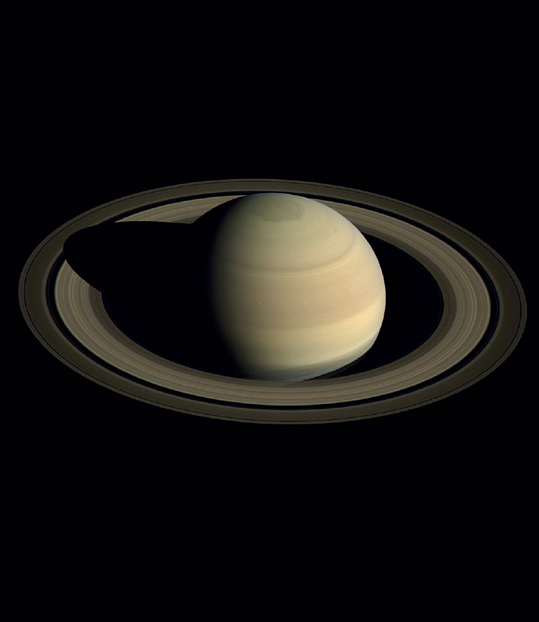c. 4.5 Billion BCE
Saturn
There might be no more enchanting experience to a fan of astronomy than viewing Saturn and its glorious rings through a small telescope. The scene is almost surreal: a shimmering, egg-shaped orb hanging against the blackness of space and girded by what seems like an incredibly delicate, thin disk of material almost twice as wide as the planet itself. It is truly one of the gems of the sky.
Saturn is the second largest of the gas giants, more than nine times wider and nearly one hundred times as massive as Earth. The flat disk that circles the planet’s equator is, of course, the famous Rings of Saturn. Composed mostly of ice, the ring system is probably no more than 22 to 33 yards (20 to 30 meters) thick. No one knows whether the rings of Saturn are an ancient, primordial feature, or whether they are a relatively new feature, perhaps formed from the catastrophic breakup of a former icy moon. Accompanying Saturn are 62 known moons, hundreds of smaller “moonlets” embedded in the rings, and billions of ring particles ranging from the size of houses and cars to specks of dust. Saturn’s largest moon, Titan, is larger than Mercury and is the only moon in the solar system with a thick atmosphere.
Saturn’s clouds and haze bands are fainter and less colorful than Jupiter’s, although the composition of the atmosphere is fairly similar. Perhaps the biggest chemical difference between Saturn and Jupiter is that, for reasons not fully understood, Saturn has a little less helium relative to hydrogen, making it less “solar” than Jupiter. Another mystery is why the wind speeds on Saturn are much higher than on Jupiter, or anywhere else in the solar system—more than 1,120 miles (1,800 kilometers) per hour in places! Detailed studies of Saturn and Jupiter by the Pioneer, Voyager, Galileo, and Cassini spacecraft show us that not all gas giants are the same. As we discover more gas giants among the extrasolar planets, those worlds, too, are likely to be both lovely and enigmatic.
SEE ALSO Titan (1655), Saturn Has Rings (1659), Pioneer 10 at Jupiter (1973), Pioneer 11 at Saturn (1979), Voyager Saturn Encounters (1980, 1981), First Extrasolar Planets (1992), Galileo Orbits Jupiter (1995), Cassini Explores Saturn (2004–2017).
NASA Cassini orbiter photo of Saturn’s northern hemisphere in 2016, as that part of the planet neared summer solstice. Distinctive cloud zones can be seen in the planet’s atmosphere, as well as the enigmatic, darker, hexagon-shaped zone surrounding the north pole.
